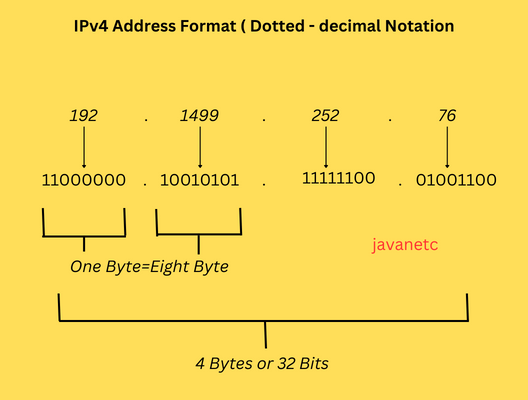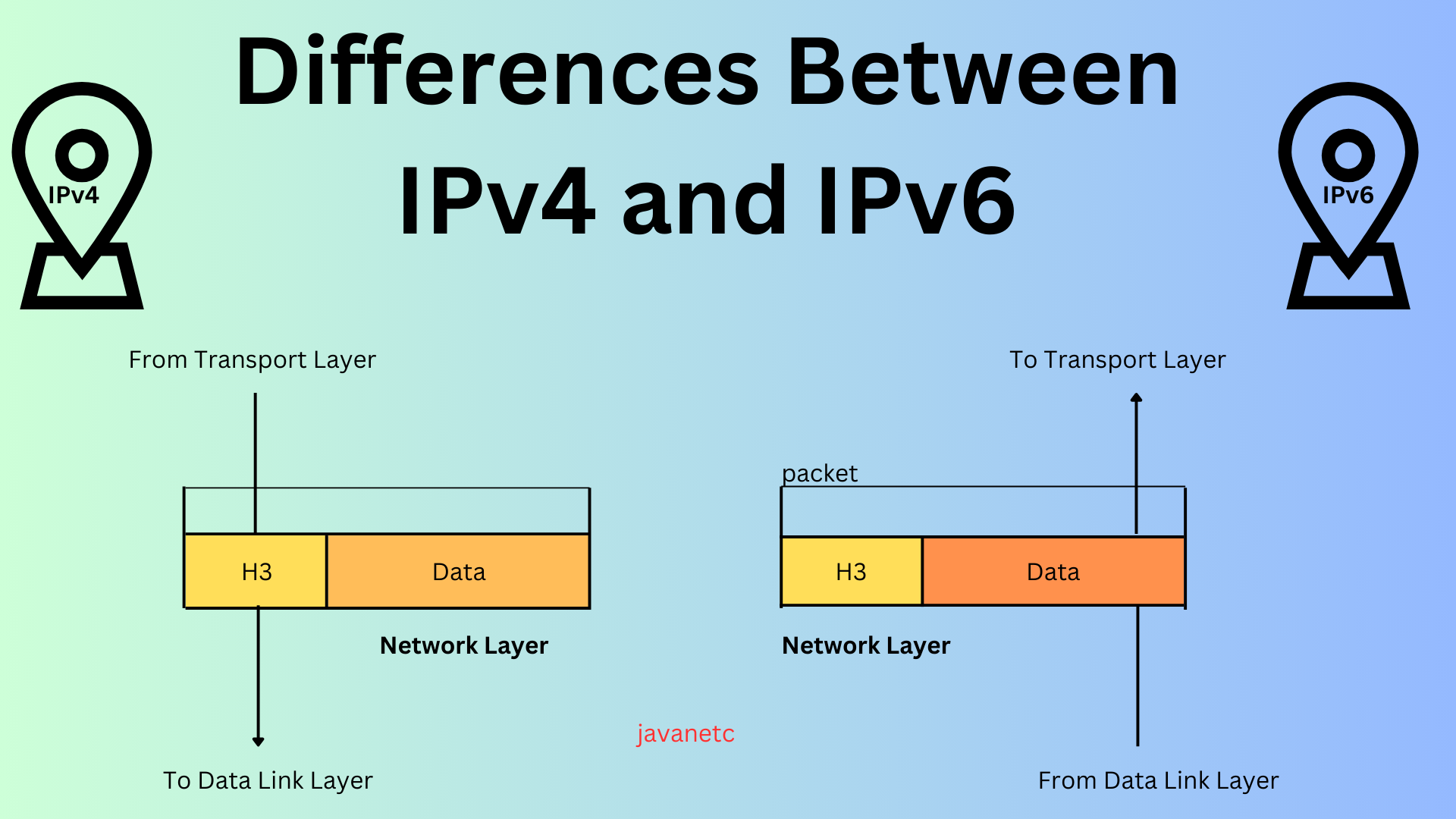Introduction IPv4 and IPv6
IP, short for Internet Protocol, serves as a unique network address assigned to every device connected to a particular network. Devices utilize IP addresses to communicate with one another within the network. The two most commonly utilized versions of IP addresses are IPv4 and IPv6. IPv4, comprised of 32 bits, is represented as a sequence of four numbers separated by dots. Each sequence, or octet, of numbers denotes a portion of the IPv4 address. IPv6, considered the successor to IPv4, boasts a larger address size of 128 bits, enabling an immense number of unique addresses, approximately 340 undecillion. IPv6 addresses are represented in hexadecimal format, with colons used to separate segments. Each segment of an IPv6 address consists of 16 bits, also referred to as blocks or segments.
Table of IPv4 and IPv6
Networking Layer
The Network Layer, situated as the third layer in the OSI model, serves as the intermediary for communication between hosts across different networks. It takes the data received from the Transport Layer and segments it into packets. This layer offers two primary modes of communication: connection-oriented and connectionless.
Here are the core functions of the Network Layer:
- Logical Addressing: When packets cross network boundaries, the Network Layer appends logical addresses, notably IP addresses (Internet Protocol addresses).
- Routing: This involves determining the optimal path from a source to a destination among multiple available paths.
- In scenarios where multiple devices are connected to a single router, there’s a risk of packet drop due to potential overload.
At this layer, various protocols are employed, including IPv4, IPv6, and ICMP (Internet Control Message Protocol). Devices utilized within this layer include routers and brouters.

IP (Internet Protocol) serves as the mechanism for assigning network addresses to each connected device, enabling communication within the network. Devices utilize IP addresses to identify and communicate with one another. Typically, IP addresses are used in conjunction with TCP (Transmission Control Protocol) to establish virtual connections between source and destination for data transmission.
Let’s summarize some key features of IP addresses:
- IP addresses are numerical values assigned by the network to each device within a particular network.
- Since IP addresses are assigned by network providers or ISPs (Internet Service Providers), they can vary across networks and are subject to change.
- Each device within a network possesses a unique IP address.
- An IP address comprises two components: the network address and the host address.
- IP addresses come in two primary types: IPv4 and IPv6 , each offering distinct features and addressing capabilities.
What is IPv4?
IPv4, short for Internet Protocol Version 4, serves as one of the most widely used systems for device identification on networks. It comprises 32 bits, represented as a sequence of four numbers separated by periods. Each period delineates an octet, consisting of 8 bits. The value of each octet ranges from 0 to 255, resulting in a total of 4,294,967,296 (2^32) possible unique addresses.
To facilitate computer processing, IPv4 addresses are converted into binary digits (0s and 1s).
IPv4 is categorized into five classes: A, B, C, D, and E. An example of an IPv4 address is 76.124.119.133.
However, IPv4 faces a significant limitation: its maximum capacity of 4 billion unique addresses. With the world’s population exceeding 7.6 billion and the prevalence of multiple devices per person, the demand for IPv4 addresses has exceeded its supply. This limitation spurred the development of IPv6 addresses.
IPv6 addresses resolve this issue by offering a vastly expanded address space. We’ll delve into IPv6 addresses in more detail in the following sections.
Although various techniques like network and port address translation, inter-domain translation, and variable-length masking were developed to alleviate the IPv4 address limitation, they proved inadequate to meet the overall demand.

Let us look at the drawback in brief:-
The limitation of IPv4, with its maximum capacity of 4 billion unique addresses, has become evident as the global population surpasses 7.6 billion and individuals possess multiple devices. This has led to a shortfall in available IPv4 addresses, making it insufficient to connect all devices to the network or the Internet. Consequently, the development of IPv6 addresses was necessitated to address this issue.
- IPv6 addresses offer a significantly expanded address space compared to IPv4, allowing for a vast number of unique addresses to accommodate the growing number of devices. In addition to providing more addresses, IPv6 also brings improvements in efficiency, security, and network management.
- Despite efforts to mitigate IPv4 address limitations through techniques like network and port address translation, inter-domain translation, and variable-length masking, they have not fully addressed the overall demand for addresses.
- In the following sections, we’ll explore IPv6 addresses in detail, including their structure, features, and benefits compared to IPv4.
Features of IPv4:
- IPv4 employs 32-bit addresses, enabling around 4.3 billion unique addresses.
- IPv4 addresses are presented in decimal format (e.g., 192.168.1.1) for straightforward human interpretation.
- IPv4 supports subnetting and Variable Length Subnet Mask (VLSM) to enhance network management efficiency.
- IPv4 facilitates broadcasting, enabling a single packet to reach all devices on a network.
- NAT conserves IPv4 addresses by permitting multiple devices within a private network to share a single public IP address.
What is IPv6?
IPv6, or Internet Protocol Version 6, represents the next generation of IPv4. Unlike IPv4, which utilizes 32-bit addresses, IPv6 employs a larger address size of 128 bits. This expanded address space allows for an immense number of unique addresses, estimated at 340 undecillion (3.4×10^38).

While IPv4 addresses are represented in decimal format using octets, IPv6 addresses utilize hexadecimal notation, incorporating both numbers and alphabets. These hexadecimal values are separated by colons, with each field consisting of 16 bits, also referred to as segments or blocks.
An example of an IPv6 address is: 2001:0db8:85a3:0000:0000:8a2e:0370:7334.
In the next section, we’ll delve deeper into the comparison between IPv4 and IPv6, exploring their differences and advantages.
In IPv6 addresses, if there are consecutive groups of zeros, they can be condensed using a double colon (“::”) notation. This convention simplifies the representation of IPv6 addresses.
An IPv6 address comprises three main parts:
- Site prefix: The first three fields of an IPv6 address constitute the site prefix. This prefix is assigned to a site by an Internet Service Provider (ISP).
- Subnet ID: The subsequent field in an IPv6 address denotes the subnet ID, which describes the topology of the network within the site.
- Interface ID: The last four fields of an IPv6 address represent the interface ID, which uniquely identifies an individual host on the network.
Features of IPv6
- IPv6 boasts a significantly larger address space, accommodating nearly 340 undecillion unique addresses.
- The header field of IPv6 is simplified, enhancing efficiency.
- IPv6 supports anycast, a routing method enabling requests to be directed to multiple locations.
- IPv6 offers end-to-end connectivity, eliminating the need for Network Address Translation (NAT) to reach other hosts.
- With its streamlined header, IPv6 facilitates fast forwarding of data packets.
- IPv6 does not support broadcasting; however, unicast and multicast operations are achievable.
- Note: Anycast involves routing incoming requests to various locations, while broadcasting transfers requests to all devices on the network.
Differences Between IPv4 and IPv6
IPv4 and IPv6 Differences
| Feature | IPv4 | IPv6 |
|---|---|---|
| Protocol Name | Internet Protocol Version 4 (IPv4) | Internet Protocol Version 6 (IPv6) |
| Addressing Format | Numeric | Alphanumeric (hexadecimal) |
| Address Size | 32-bits (4 octets) | 128-bits (8 segments) |
| Unique Addresses | 4 billion | Over 340 undecillion |
| Address Separators | Periods (.) | Colons (:) |
| Address Operations | Unicast, Broadcast, Multicast | Unicast, Anycast, Multicast (No broadcasting) |
| Classes | Class A to Class E | No classes |
| Header Fields | 12 fields | 8 fields |
| Header Length | 20-bits | 40-bits |
| Checksum Field | Yes | No |
| Fragmentation | Sending and Forwarding Routers | Sender |
| Variable Length Subnet Mask | Supported | Not supported |
| Network Configuration | Manual or DHCP | Automatic |
| Connection Integrity | Limited | Achievable |
| Encryption and Authentication | Not provided | Provided |
| Flow Label for Packet Flow ID | No | Yes |
| Security | Application-dependent | Enhanced with IPsec |
| Example of Address | “86.124.49.54” | “1851:0000:3238:DEF1:0177:0000:0000:0125” |
| Address Representation Format | Decimal | Hexadecimal |
| Address Usage | Public and Private Addresses | Primarily for Global Communication, no NAT needed |
| Address Space Limitations | Limited, requiring NAT for conservation | Vast, mitigating address exhaustion concerns |
These differences IPv4 and IPv6 highlight the advancements and improvements that IPv6 brings over IPv4, particularly in terms of address space, header simplicity, security features, and automatic network configuration. IPv6 addresses the limitations of IPv4 and supports the growing needs of a connected world.
Conclusion IPv4 and IPv6
- IPv4’s 32-bit addressing system has become inadequate due to the exponential growth of connected devices, necessitating the development of IPv6 with its significantly expanded address space.
- IPv6’s 128-bit addressing system offers an almost boundless pool of unique addresses, effectively resolving the address scarcity issue experienced by IPv4.
- IPv4 utilizes decimal notation for addressing (e.g., “192.168.1.1”), while IPv6 employs hexadecimal format (e.g., “2001:0db8:85a3:0000:0000:8a2e:0370:7334”).
- IPv6 simplifies network configuration by facilitating automatic processes, contrasting with IPv4, which often requires manual intervention or DHCP.
- IPv6 integrates the IPsec protocol, ensuring encryption and authentication, thereby establishing a more inherently secure communication framework compared to IPv4, which relies on application-level security.



